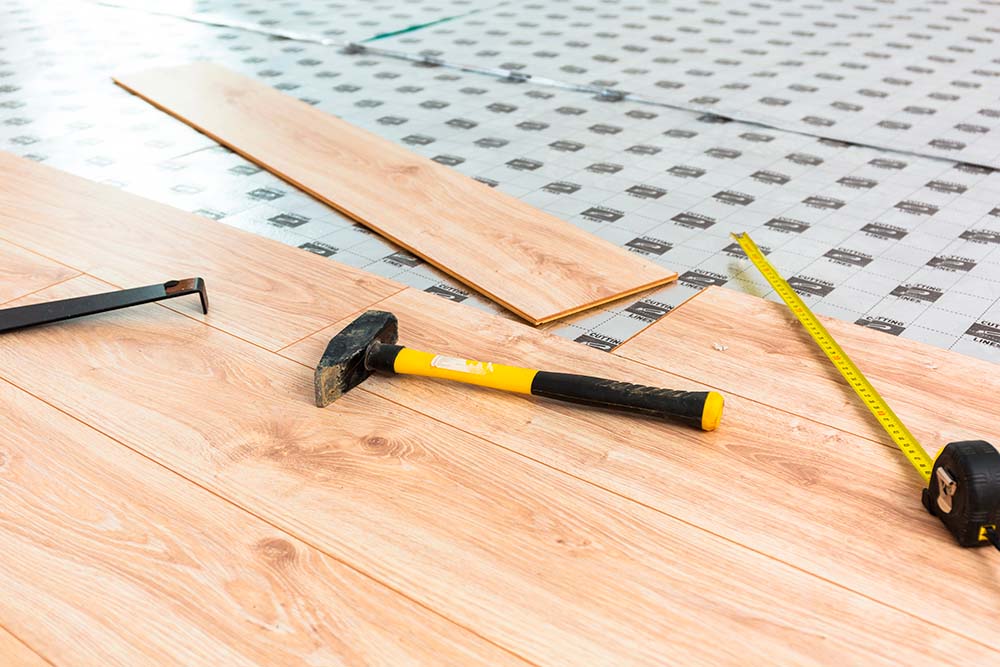Can you put laminate over tile? This question often comes up when considering a flooring makeover. Done right, it offers a smooth, stylish finish without the hassle of tearing out existing tiles.
In this guide, we’ll walk you through the essential steps and considerations to ensure your laminate flooring installation is seamless and durable.


Assessing the Existing Tile Surface
Before you start installing laminate over tile, it’s crucial to assess the existing tile surface. Ensuring that the tiles are firmly adhered and free of damage is key to a successful laminate flooring installation. Skipping this step can lead to uneven floors and potential issues down the road.
Start by checking each tile for stability. Walk across the tiled area, paying attention to any movement or shifting underfoot.
Loose or damaged tiles can create an unstable base, causing the laminate to buckle or crack over time. If you notice any tiles that are loose or making noise, you’ll need to address these before proceeding.
To identify problem tiles, look for:
- Cracks
- Chips
- Missing pieces
Tap gently on the tiles with a rubber mallet and listen for a hollow sound, which indicates that the tile is not properly adhered to. Mark any tiles that need attention.
Fixing loose or damaged tiles is straightforward. For loose tiles, remove them carefully and clean out any old adhesive or debris from the space.
Apply a new layer of tile adhesive and press the tile back into place, ensuring it’s level with the surrounding tiles. Allow the adhesive to dry completely. For cracked or chipped tiles, it’s best to replace them entirely to maintain a smooth, even surface.
Preparing the Tile Surface for DIY Laminate Installation
Creating a smooth substrate is essential for a successful laminate flooring installation over tile. You should fill in grout lines and any imperfections to ensure an even surface.
First, gather the necessary tools and materials. You will need:
- Tile cleaner
- Vacuum
- Sponge
- Grout float
- Leveling compound
- Trowel
- Sanding block
Begin by thoroughly cleaning the tile surface. Use a tile cleaner to remove any dirt, grease, or residue.
After cleaning, vacuum the area to pick up any remaining dust and debris. A clean surface ensures better adhesion for the leveling compound.
Next, address the grout lines. These lines create uneven surfaces that can affect the laminate installation.
To fill them, use a leveling compound. Apply the compound with a trowel, spreading it evenly over the grout lines and any imperfections. Use a grout float to press the compound into the lines, ensuring they are completely filled.
After applying the leveling compound, allow it to dry according to the manufacturer’s instructions. This usually takes several hours.
Once dry, use a sanding block to smooth out any high spots or uneven areas. The goal is to create a perfectly flat and level surface for the laminate.
Finally, check the surface with a level to ensure it is even. If you find any low spots, apply additional leveling compound and sand it down again after it dries. Repeat this process until the entire surface is smooth and level.
Choosing the Right Underlayment
Picking the right underlayment is key for a successful laminate flooring installation over tile. The underlayment acts as a buffer, offering stability, sound absorption, and moisture protection.
First up is foam underlayment. It’s a popular choice because it’s easy to install and provides good cushioning, making the floor comfortable to walk on. Foam also helps reduce noise, which is great if you’re installing in a busy area.
When installing laminate over tile, look for foam underlayment with a built-in moisture barrier to guard against any moisture that might seep through the tiles.
Next is cork underlayment. This option is excellent for soundproofing an insulation. Cork is thicker than foam, offering better support and comfort underfoot.
It’s also resistant to mold and mildew, perfect for areas with higher humidity. However, make sure the cork underlayment is compatible with both your tile and laminate flooring, especially in terms of thickness and moisture protection.
Rubber underlayment is another strong contender. It excels in sound insulation and durability, making it suitable for high-traffic areas.
Rubber is heavier and denser than foam or cork, providing robust support and water resistance. However, it can be pricier and more challenging to install. Ensure your rubber underlayment is suitable for use over tile and under laminate.
Lastly, there’s felt underlayment. Made from recycled fibers, it offers great sound insulation and cushioning. Felt is durable and provides good thermal insulation, which helps keep floors warmer.
It’s also eco-friendly, but make sure it includes a moisture barrier if used over tile. Check compatibility with your laminate flooring to ensure a proper fit.
When choosing the right underlayment, consider these factors:
- Moisture protection
- Thickness
- Sound insulation
- Comfort

Installing the Underlayment
Laying an underlayment over your existing tile is crucial for a smooth laminate flooring installation. Start by thoroughly cleaning the tile surface to remove dust and debris. A clean surface ensures proper adhesion.
Roll out the underlayment, starting at one end of the room. If there is a moisture barrier, ensure it faces down.
Cut the underlayment to fit the room with a utility knife, laying pieces edge-to-edge without overlapping. Secure seams with underlayment tape to keep them in place and maintain a continuous moisture barrier.
Address height transitions between rooms by using transition strips or reducers. Measure the height difference and choose a strip that matches the thickness of your underlayment and laminate. Install the strip as per the manufacturer’s instructions for a smooth transition.
Ensure proper adhesion of the underlayment. Some underlayments are self-adhesive, while others may require adhesive spray or double-sided tape.
Follow the manufacturer’s guidelines for the best results.
Steps to Install Laminate Flooring Over Tile
Now that you’ve prepared your tile surface and chosen the right underlayment, it’s time to install the laminate flooring.
Start by measuring your room to determine how much laminate flooring you need. Lay out the first row of laminate planks along the longest wall, using spacers to maintain a gap of about 1/4 inch from the wall.
Cut the first plank to fit the space. To do this, measure the plank and mark where it needs to be cut. Use a circular saw or a laminate cutter to make the cut.
Next, click the first plank into place. Most laminate flooring uses a tongue-and-groove system. Angle the plank slightly and insert the tongue into the groove of the adjacent plank, then press down to lock it in place.
Continue laying the first row, cutting the last plank to fit if necessary. Start the second row with a plank cut to about two-thirds of its length. Repeat the clicking process, making sure each plank fits snugly.
As you progress, use a tapping block and a rubber mallet to ensure the planks are tightly connected. Lay each row, checking that the seams are tight and the planks are level. If you encounter obstacles like doorways or corners, measure and cut the planks to fit around them.
Once all the planks are laid, remove the spacers and install the baseboards or moldings to cover the expansion gap.
Pay Attention to Thermal Expansion
One critical aspect of laminate flooring is managing thermal expansion and contraction. This type of flooring can expand and contract with temperature changes, so maintaining that 1/4-inch gap around the perimeter is crucial.
Use spacers to keep the gap consistent as you lay the planks.

Troubleshooting Common Challenges
Moisture can wreak havoc on laminate flooring. To prevent this, always use an underlayment with a built-in moisture barrier. Check for any signs of moisture on the tile surface before installation.
If you find any damp areas, address the source of the moisture and ensure the surface is completely dry before proceeding. Using a dehumidifier can help in particularly humid areas.
Height differences between rooms can be tricky. Use transition strips or reducers to create a seamless transition. Measure the height difference accurately and choose a strip that matches the thickness of your underlayment and laminate.
Follow the manufacturer’s instructions to install the strip correctly, ensuring it’s secure and smooth.
Solutions for Common Installation Problems
If you discover loose tiles during the prep stage, fix them before laying the underlayment. Remove the loose tile, clean the area, and reapply the adhesive to secure it in place.
Uneven grout lines or tile surfaces can cause issues. Use a leveling compound to fill in low spots and create a smooth surface for the underlayment and laminate.
Remember to maintain a 1/4-inch expansion gap around the room’s perimeter. This allows for thermal expansion and contraction of the laminate, preventing buckling.
When cutting laminate planks to fit around corners or obstacles, measure twice to ensure accuracy. Use a fine-toothed saw for clean cuts and to minimize chipping.
Can You Put Laminate Over Tile? Yes, You Can
Installing laminate over tile is a smart way to upgrade your floors without the hassle of removing existing tiles. By following our guide, you’ll achieve a smooth, professional finish.
Ready to transform your space? At RUBI, we evolve daily with professionals worldwide, providing the tools needed for the best results.
Join us in building the future together with reliable, high-quality tools designed for your success. Browse our products today!


Post a comment